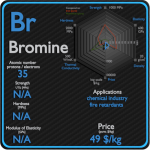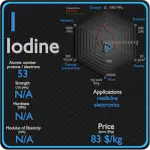This article contains comparison of key thermal and atomic properties of chlorine and bromine, two comparable chemical elements from the periodic table. It also contains basic descriptions and applications of both elements. Chlorine vs Bromine.

Chlorine and Bromine – About Elements


Source: www.luciteria.com
Chlorine and Bromine – Applications
Chlorine
Chlorine is used in the manufacture of a wide range of consumer products, about two-thirds of them organic chemicals such as polyvinyl chloride (PVC), many intermediates for the production of plastics, and other end products which do not contain the element. As a common disinfectant, elemental chlorine and chlorine-generating compounds are used more directly in swimming pools to keep them sanitary. While perhaps best known for its role in providing clean drinking water, chlorine chemistry also helps provide energy-efficient building materials, electronics, fiber optics, solar energy cells, 93 percent of life-saving pharmaceuticals, 86 percent of crop protection compounds, medical plastics, and much more.
Bromine
A wide variety of organobromine compounds are used in industry. Some are prepared from bromine and others are prepared from hydrogen bromide, which is obtained by burning hydrogen in bromine. Brominated flame retardants represent a commodity of growing importance, and make up the largest commercial use of bromine. One of the major uses of bromine is a water purifier/disinfectant, as an alternative to chlorine. Bromine compounds are effective pesticides, used both as soil fumigants in agriculture, particularly fruit-growing, and as a fumigant to prevent pests from attacking stored grain and other produce.
Chlorine and Bromine – Comparison in Table
| Element | Chlorine | Bromine |
| Density | 0.0032 g/cm3 | 3.12 g/cm3 |
| Ultimate Tensile Strength | N/A | N/A |
| Yield Strength | N/A | N/A |
| Young’s Modulus of Elasticity | N/A | N/A |
| Mohs Scale | N/A | N/A |
| Brinell Hardness | N/A | N/A |
| Vickers Hardness | N/A | N/A |
| Melting Point | -101 °C | -7.3 °C |
| Boiling Point | -34.6 °C | 59 °C |
| Thermal Conductivity | 0.0089 W/mK | 0.122 W/mK |
| Thermal Expansion Coefficient | N/A | N/A |
| Specific Heat | 0.48 J/g K | 0.473 J/g K |
| Heat of Fusion | 3.23 kJ/mol | 5.286 kJ/mol |
| Heat of Vaporization | 10.2 kJ/mol | 15.438 kJ/mol |

















